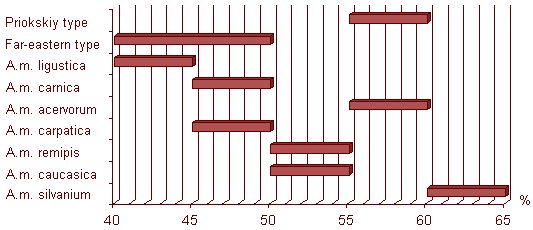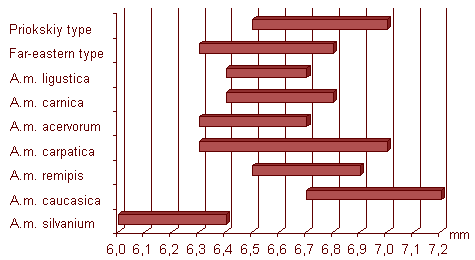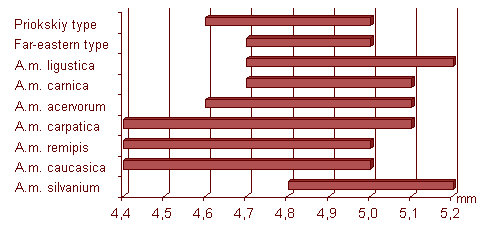determination of Apis mellifera
According to many researchers uncontrolled delivery of bees and their crossbreeding with the local bees comes to the increasing anomaly of bees’ development. It raises the bees’ death at winter period and it reduces the resistance of bees to some diseases. Also crossbreeding of bees comes to high swarming and, as an effect, it makes hard work on the apiary and promotes spreading of the multiple diseases. Finally, uncontrolled crossbreeding of the local bees’ population and the following degeneration of them lowers the productivity of bees’ families into 1,5 - 2 times. It’s obviously that for increasing of the productivity of beekeeping branch of the agriculture it’s necessary to do qualitative selective breeding work not only on the level of the country or a region, but on the level of each apiary. Many beekeepers are ready to do such work on their own apiaries, but there are some difficulties in the quantity of morphometric signs for pure strain determination of the bees.
According to the recommendations of the All-Russian bee scientific research institute at present time in Russia for bees’ pure strain determination it’s necessary to study three morphometric signs. They are: the proboscis length, the third tergite width and the size of cubital index (the indicator panel. 1.).
Table 1. Morphometric signs of the bees’ races which are the most wide-spread in Russia
Bees’ race |
Proboscis length, mm |
Cubital index, % |
Third tergite, mm |
A.m. silvanium |
6,0-6,4 |
60-65 |
4,8-5,2 |
A.m. caucasica |
6,7-7,2 |
50-55 |
4,4-5,0 |
A.m. remipis |
6,5-6,9 |
50-55 |
4,4-5,0 |
A.m. carpatica |
6,3-7,0 |
45-50 |
4,4-5,1 |
A.m. acervorum |
6,3-6,7 |
55-60 |
4,6-5,1 |
A.m. carnica |
6,4-6,8 |
45-50 |
4,7-5,1 |
A.m. ligustica |
6,4-6,7 |
40-45 |
4,7-5,2 |
Far-eastern type |
6,3-6,8 |
40-50 |
4,7-5,0 |
Priokskiy type |
6,5-7,0 |
55-60 |
4,6-5,0 |
However, some beekeepers and scientists both in our country and abroad offer to shorten the amount of measured morphometric signs to the only one (the cubital index) or sometimes to two signs (the proboscis length and the cubital index).
We have decided to check the validity and practicability of these statements. The importance of each sign was estimated with its informative data for pure strain determination of the bees and was fixed by means of method of casual searching with adaptation (the algorithm SPA). For more validity we used 14 morphometric signs: the proboscis length, the width and length of the third tergite, of the third sternite, of the right wax mirror, of the right front and back wings, the amount of the wing hooks on the front edge of the right back wing, the cubital and tarsal index. For the research 900 bees were taken; all of them were the representatives of 9 races (we took 100 bees of each sort).
As a result, the most informative signs which were found with the programme were three: the cubital index, the proboscis length and the width of the third tergite. The rest explored signs were statistical unauthentic and were distributed casually. The most informative value had the cubital index, which was evaluated approximately with 74%. Seeing on the figure1 we may notice that only the A.m. silvanium type can be determined with the means of the cubital index.

The length of the proboscis was evaluated approximately with 21 %. As we can see on the figure 2 it’s possible to define the only A.m. silvanium and grey mountain caucasian races of bees with the means of the proboscis length, but nevertheless not in all cases.

The width of the third tergite was evaluated with 5% only. On the figure 3 it is seen that it’s impossible to select the races of the bees according to this sign.

However, in spite of the most informative parameter as the value of the cubital index for determination of bees’ pure strain, we don’t consider to select this parameter as the only morphometric criterion. Because it’s known that the rest two morphometric signs, used for pure strain determination of the bees in modern methods, are connected with the economic useful signs of the bees. For example, bees’ visit of the determined length of the flowers’ corolla is dependent on the proboscis length; so honey gathering and the quality of the pollination are dependent on this parameter (it’s known that a A.m. silvanium bee has a short proboscis and so it pollinates the red clover badly). And the width of the third tergite is dependent on the value of the bee’s body.
That’s why we recommend to pay attention to all three morphometric signs (the proboscis length, the third tergite width and the size of cubital index) for pure strain determination of Apis mellifera, recommended by the All-Russian bee scientific research institute.
1. Загоруйко Н.Г., Елкина В.Н., Емельянов С.В., Лбов Г.С. Пакет прикладных программ ОТЭКС. М.: Финансы и статистика, 1986.
2. Лбов Г.С. Методы обработки разнотипных экспериментальных данных. Но-восибирск: Наука, 1981.